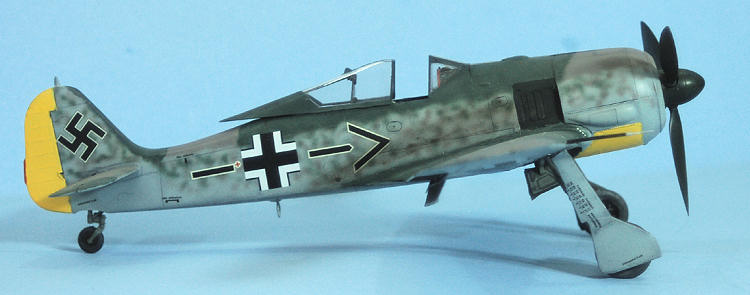
Hasegawa 1/32 FW-190A-4 (Conversion)
| KIT #: | 08169 |
| PRICE: | Approx. $70.00 MSRP |
| DECALS: | Two options |
| REVIEWER: | Tom Cleaver |
| NOTES: | Conversion of A-5 kit |

| HISTORY |
1942 could be called “the year of the Wurger.”
While only 224 Fw-190As had been accepted by the Luftwaffe by the
end of 1941, 1,878 would be produced at three different factories during 1942,
the third being the Fieseler plant at
The last of the early “short-nose” Focke-Wilf fighters, the Fw 190A‑4,
introduced on the production lines over the summer of 1942.
This sub-type differed from the preceding Fw-190A-3 by being equipped
with MW 50 power boost system to obtain additional power below the rated
altitude of the BMW 801D-2 engine. By injecting a water‑methanol mixture into
the cylinders, the engine could briefly sustain a compression over the redline
and get a little more horsepower.
Beyond this, the only real difference from the A‑3, the A‑4 also added a short
radio antenna atop the vertical fin. The Fw-190A-4 was the most-produced sub-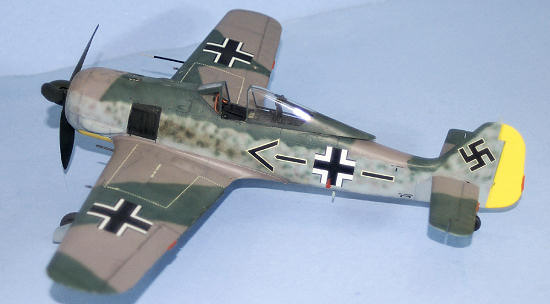 type
of the early Fw-190s.
type
of the early Fw-190s.
JG 26 On The Channel Front:
Following the end of the
The RAF offensive that commenced in the Spring of 1941 was the brainchild
of Air Marshal Sholto Douglas who had replaced Air Marshall Dowding as
Commander-in-chief of Fighter Command, and Air Marshal Trafford Leigh-Mallory
who had replaced Keith Park at OC 11 Group.
Both of these officers had spent the
The fact was that the RAF had no way to actually threaten the Germans
over northwestern Europe, due to the short range of the Spitfire and the
Hurricane, and the complete unsuitability of British bombers to protect
themselves to any degree against fighters, requiring a massive commitment of
fighter escorts and thus limiting the penetration of enemy air space to the
range of these point-defense interceptors.
Thus, the RAF was incapable of mounting more than pinprick attacks
against German fighter fields in extreme northwestern
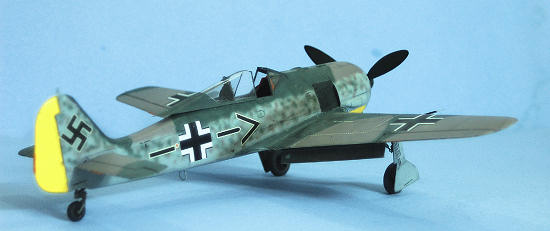 Throughout 1941 and most of 1942, the two German Geschwadern had
no trouble maintaining air superiority against RAF Fighter Command over Occupied
Europe, inflicting casualties on the RAF that on occasion were the equal of the
bloody days of Bloody April, 1917.
All they had to do was keep Fighter Command’s losses at five percent per raid or
more, and over time the RAF would be bled white as the Luftwaffe had been the
previous summer over
Throughout 1941 and most of 1942, the two German Geschwadern had
no trouble maintaining air superiority against RAF Fighter Command over Occupied
Europe, inflicting casualties on the RAF that on occasion were the equal of the
bloody days of Bloody April, 1917.
All they had to do was keep Fighter Command’s losses at five percent per raid or
more, and over time the RAF would be bled white as the Luftwaffe had been the
previous summer over
During 1941, Adolf Galland's careful management of his aircraft resources
and his astute tactical awareness resulted in JG 26 keeping losses to a minimum
while inflicting maximum damage on the RAF. By the end of 1941 JG 26 claimed
over 900 victories since September 1939, 400 since May 1941, for the loss of 95
pilots killed with 34 made POW in return.
Following the death of Werner Mölders in November 1941, Galland was
promoted to General der Jagdflieger, and was replaced as Geschwader Kommodore by
Gerhard Schöpfel that December.
Schöpfel would lead JG 26 through the momentous year of 1942.
Born December 19, 1912 at Erfurt in Thüringen, Gerhard “Gerd” Schöpfel
transferred to the Luftwaffe in 1936 from service in the police. After
his flying training, Schöpfel was assigned to I./JG 233 which became I./JG 135
and, finally, I./JG 51. In early 1939, Leutnant Schöpfel joined I./JG 26
and commanded 9./JG 26 from its
formation on September 23, 1939. Schöpfel scored his first victory during the
Battle of France, shooting down a RAF Hurricane near Courtrai on May 19. He
scored additional victories in fighting over Dunkirk and became very successful
during the Battle of Britain, shooting down four Hurricanes on August 18, 1940
over Canterbury, England. Two of his victims were leading RAF fighter pilots -
Donald McKay (20 confirmed), who baled out wounded, and Kenneth Lee (7
confirmed), who also baled out wounded, both of 501 Squadron. Hauptmann
Schöpfel became Gruppenkommandeur of
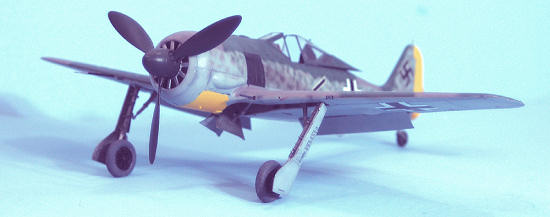 Schöpfel was promoted to Major on December 1, and on December 6,
1941, became Kommodore of JG 26.
His first big operation was Operation Cerberus, known as “The Channel
Dash,” during which JG 26 provided the air support for the breakout of the
German warships Scharnhorst, Gneisenau and Prinz Eugen
through the English Channel from Brest to Kiel.
Schöpfel was promoted to Major on December 1, and on December 6,
1941, became Kommodore of JG 26.
His first big operation was Operation Cerberus, known as “The Channel
Dash,” during which JG 26 provided the air support for the breakout of the
German warships Scharnhorst, Gneisenau and Prinz Eugen
through the English Channel from Brest to Kiel.
Schöpfel continued to score as Kommodore during the rest of the
spring and summer of 1942. The high
point of his command came on August 19, 1942 when he shot down two Spitfires
over Dieppe for his 41st and 42nd victories during the “reconnaissance in force”
by the Allies. The air operations in conjunction with Operation Jubilee
saw some of the fiercest, most intense air battles since 1940. The RAF committed
51 squadrons of Spitfire and Typhoon fighters, eight squadrons of Hurricane
fighter-bombers, four squadrons of Mustang reconnaissance fighters and seven
squadrons of light bombers, with the aim of protecting the Allied naval and land
forces and forcing the Luftwaffe into an battle of attrition on the
Allies’ terms. Opposing this force were 115 operational fighters of JG 2 and JG
26, which were thus outnumbered by about three to one.
While the Luftwaffe was initially
slow to respond to the raid, the fighters made their presence felt over the port
as the day wore on. While the Allied fighters were moderately successful in
protecting the ground and sea forces from aerial bombing, the RAF came off
second best in air combat against the experienced German fliers. While Fighter
Command claimed to have inflicted heavy casualties on the Luftwaffe the
balance sheet showed the reverse:
Allied losses totaled 106, including 88
 fighters - of
which 70 were Spitfires - and 18 bombers.
The Luftwaffe lost a total of 48 aircraft lost, including in that total
were 28 bombers, 14 of them Do-217s from KG 2. JG 2 lost 14 Fw-190s and eight
pilots killed, while JG 26 lost six Fw 190s with their pilots. The Luftwaffe
claimed 61 of the 106 RAF loses, with JG 2 claiming 40 while JG 26 claimed 21.
fighters - of
which 70 were Spitfires - and 18 bombers.
The Luftwaffe lost a total of 48 aircraft lost, including in that total
were 28 bombers, 14 of them Do-217s from KG 2. JG 2 lost 14 Fw-190s and eight
pilots killed, while JG 26 lost six Fw 190s with their pilots. The Luftwaffe
claimed 61 of the 106 RAF loses, with JG 2 claiming 40 while JG 26 claimed 21.
Schöpfel left JG 26 on January 10, 1943, to become Operations Officer at Jafü Brittany. He served as Fighter Operations Officer Southern Italy between July-November 1943, then became Fighter Leader Norway. On June 1, 1944, he was appointed Kommodore of JG 4. On August 6, 1944 he was shot down in combat near Schwerin flying a Bf 109 G‑6 and baled out wounded. In November 1944, he was appointed Fighter Leader Hungary. In February 1945 he became commander of the Luftkreigsschule at Gatow. On April 10, 1945, he was became Kommodore of JG 6 in northern Czechoslovakia. Following surrender to the Soviets, he was a POW until he returned to Germany in December 1949. After his return, Schöpfel worked as a chauffeur, and later became a merchant. In the early 1960s he became an executive of Air Lloyd in Bonn.
| THE KIT |
The Fw-190A-5 kit is as close as Hasegawa has gotten to doing an early Wurger. The kit is basically the Fw-190A-8, with different fuselage gun cowling, and different gear door covers, along with the bulged cannon cover on the lower wing for the MG-FF. The kit has also been released as a virtually-similar Fw-190A-6. Both releases have been “limited”, with the Fw-190A-5 release providing markings for three aircraft flown by Josef Priller, with the Fw-190a-6 kit providing the “checkerboard” cowling for JG 1.
| CONSTRUCTION |
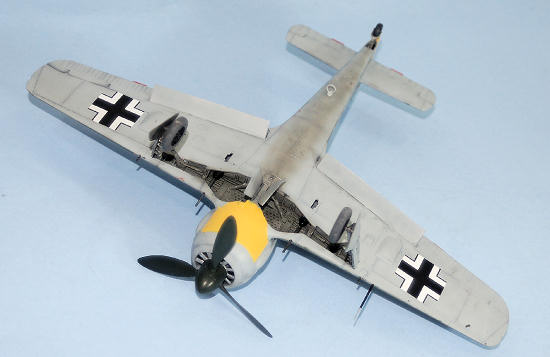
| COLORS & MARKINGS |
| FINAL CONSTRUCTION |
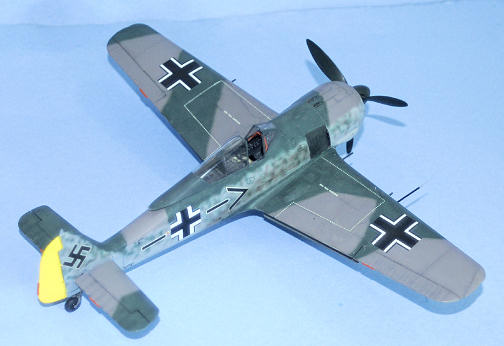
| CONCLUSIONS |
June 2010
If you would like your product reviewed fairly and quickly , please contact me or see other details in the Note to Contributors.